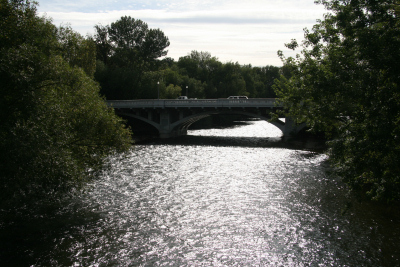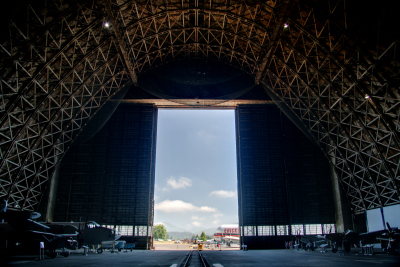
On a recent trip to Idaho, we took a walk that crossed the Boise River on a footbridge. The photo above is what I saw from the bridge: sunlight glinting off the water's wavelets, a vehicle bridge with cars, and bright picturesque clouds in the sky. Surrounding the scene was late-summer green foliage, gently moving in the breeze.
Here was the camera's best effort to capture the scene in one photo:

The sun reflections were blown out, yet the back-lit bridge was underexposed. The overexposed sky lost cloud detail, but the trees were darkened by their underexposure.
Of course, the first photo is a High Dynamic Range picture, which rescued the scene. I have discussed HDR in numerous postings in this blog, but there has always been a problem: motion. In one posting ("Dynamic World Thwarts Dynamic Range Photography"), I lament the need for multiple photos to compile an HDR shot: "Until cameras start getting built with High Dynamic Range sensors to capture contrasty motion scenes in one shot, much of the dynamic world will remain out of reach of HDR photography."
Last week, much to my chagrin, I realized that the "until" time has already arrived for many motion HDR shots -- without the need to buy new equipment. The HDR photo above is an example of that "new" technology, enabling me to capture an High Dynamic Range image from a single instant in time -- a necessary feature for any photo with liquid water, breeze-blown tree leaves, etc.
As you may know, an ordinary JPEG digital photo is composed of data with 24 bits per pixel; 8 for each primary color. So, each color channel must be expressed with an intensity number of 0-127. That significantly limits the dynamic range. Wouldn't it be nice if cameras could capture more dynamic range in each shot?
Well, DSLRs do that very thing. In my case, the Canon 400D captures 36 bits per pixel; 12 for each primary color (0-2047). Then, when it constructs the 24-bit JPEG image to be stored on the memory card, it throws away the "extra" bits after applying color balance, contrast and sharpness parameters. But the original image's data -- all 36 bits -- is still available in the RAW format file, adding one or two stops of dynamic range. Duh. (Why didn't I think of that before?)
That lets me construct a triad of three exposures by "developing" the RAW data into JPEGs that are underexposed, normal, and overexposed. Then HDR software like Photomatix takes it from there.
With this realization, I will be able decide to use HDR after the fact. And, I'm no longer troubled by motion in the scene.
Of course, an extreme case like the Tillamook Air Museum's blimp hanger still needs multiple shots; six in this case, with a 9-stop dynamic range:

But now I can reserve the time-consuming sequence shooting for the situations that truly need them.

1 comment:
The latest version of Canon's Digital Photo Professional (v3.6.1.0).
Post a Comment